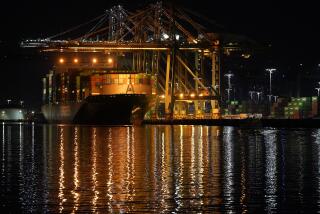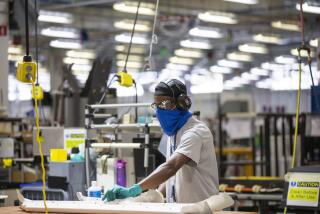Factory Output Rises; Construction Dips 1.5% : Economy: Purchasing managers see growth in manufacturing, but factory employment fell.
- Share via
WASHINGTON — The U.S. economy continued to perform erratically as factory output expanded modestly in July while construction in June posted the largest decline in more than a year.
The National Assn. of Purchasing Managers index, a barometer of factory output, rose to 54.2% in July from 52.8% in June, the sixth consecutive month of expansion, the trade group said Monday.
However, the Commerce Department’s construction report for June showed that construction spending declined 1.5%, the largest loss since the 1.8% drop in May, 1991.
“The recovery is not matching the pace of rebounds from previous recessions,” said David Cohen, an economist at MMS International in Belmont, Calif.
There was also a dark side to the manufacturing report. Factory employment decreased last month, which doesn’t bode well for Friday’s release of the July unemployment rate.
“The industrial sector of our economy will not recover to its pre-recession level until mid-1993, while employment will not recover . . . until later,” said Lawrence Hunter, chief economist at the U.S. Chamber of Commerce.
“Commercial construction will not recover fully until 1995,” Hunter said. “Indeed, this recovery will be the longest on record.”
“Given the sustained high rate of growth in new orders, it is likely that the economy will continue to continue growing at this moderate rate in the third quarter,” said Robert Bretz, chairman of the association’s survey committee.
In the purchasing managers’ index, a reading above 50% indicates that the manufacturing economy is expanding. However, the employment component of the report continued to contract, declining to 45.8 from 46.1%.
“Companies are seeing better demand but are not hiring,” said analysts at Merrill Lynch in New York. “That is good news for productivity growth and should help to keep inflation down.”
However, the analysts said, “It also suggests that Friday’s employment report will show little life in factory employment.”
The report also showed that manufacturers’ prices increased for the third consecutive month in July, suggesting the threat of inflation lurks in the shadows.
The report described last month’s gain in manufacturing inventories as a cushion intended to offset demand while factories closed for routine maintenance and vacations in August.
In the construction figures, a 1.1% increase in residential building was not enough to offset a big 5.7% drop in government construction and a 0.9% decline in private, non-residential projects.
“The large drop in June construction spending was caused by budget problems in local, state and federal budgets that led to the big falloff in government construction,” Hunter said.
June’s overall decrease to a seasonally adjusted annual rate of $416.9 billion follows a 0.1% gain in May to $423.4 billion.
The 1.5% decrease in June was the first decline since December, although the overall level was 5.7% above the $394.3 billion of June, 1991, the government said.
Construction Spending Billions of dollars, seasonally adjusted June, ‘92: 416.9 May, ‘92; 423.4 June, ‘91: 394.3 Source: Commerce Department
Purchasing Managers’ Index The purchasing managers’ index tracks overall business activity at 300 industrial companies. July 1991: 51.1% July 1992: 54.2% Source: National Assn. of Purchasing Management
More to Read
Inside the business of entertainment
The Wide Shot brings you news, analysis and insights on everything from streaming wars to production — and what it all means for the future.
You may occasionally receive promotional content from the Los Angeles Times.










